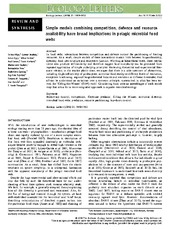| dc.contributor.author | Våge, Selina | |
| dc.contributor.author | Bratbak, Gunnar | |
| dc.contributor.author | Egge, Jorun Karin | |
| dc.contributor.author | Heldal, Mikal | |
| dc.contributor.author | Larsen, Aud | |
| dc.contributor.author | Norland, Svein | |
| dc.contributor.author | Paulsen, Maria Lund | |
| dc.contributor.author | Pree, Bernadette | |
| dc.contributor.author | Sandaa, Ruth-Anne | |
| dc.contributor.author | Skjoldal, Evy Foss | |
| dc.contributor.author | Tsagaraki, Tatiana Margo | |
| dc.contributor.author | Øvreås, Lise | |
| dc.contributor.author | Thingstad, T. Frede | |
| dc.date.accessioned | 2019-05-29T12:46:52Z | |
| dc.date.available | 2019-05-29T12:46:52Z | |
| dc.date.issued | 2018-09 | |
| dc.Published | Våge S, Bratbak G, Egge JK, Heldal M, Larsen A, Norland S, Paulsen ML, Pree B, Sandaa R, Skjoldal EF, Tsagaraki T.M., Øvreås L, Thingstad TF. Simple models combining competition, defence and resource availability have broad implications in pelagic microbial food webs. Ecology Letters. 2018;21(9):1440-1452 | eng |
| dc.identifier.issn | 1461-0248 | en_US |
| dc.identifier.issn | 1461-023X | en_US |
| dc.identifier.uri | http://hdl.handle.net/1956/19818 | |
| dc.description.abstract | In food webs, interactions between competition and defence control the partitioning of limiting resources. As a result, simple models of these interactions contain links between biogeochemistry, diversity, food web structure and ecosystem function. Working at hierarchical levels, these mechanisms also produce self‐similarity and therefore suggest how complexity can be generated from repeated application of simple underlying principles. Reviewing theoretical and experimental literature relevant to the marine photic zone, we argue that there is a wide spectrum of phenomena, including single cell activity of prokaryotes, microbial biodiversity at different levels of resolution, ecosystem functioning, regional biogeochemical features and evolution at different timescales; that all can be understood as variations over a common principle, summarised in what has been termed the ‘Killing‐the‐Winner’ (KtW) motif. Considering food webs as assemblages of such motifs may thus allow for a more integrated approach to aquatic microbial ecology. | en_US |
| dc.language.iso | eng | eng |
| dc.publisher | Wiley | en_US |
| dc.rights | Attribution CC BY | eng |
| dc.rights.uri | http://creativecommons.org/licenses/by/4.0 | eng |
| dc.subject | Bottom-up control | eng |
| dc.subject | competition | eng |
| dc.subject | Keystone predator | eng |
| dc.subject | Killing the Winner | eng |
| dc.subject | microbial diversity | eng |
| dc.subject | microbial food webs | eng |
| dc.subject | predation | eng |
| dc.subject | resource partitioning | eng |
| dc.subject | top-down control | eng |
| dc.title | Simple models combining competition, defence and resource availability have broad implications in pelagic microbial food webs | en_US |
| dc.type | Peer reviewed | |
| dc.type | Journal article | |
| dc.date.updated | 2019-01-24T08:52:13Z | |
| dc.description.version | publishedVersion | en_US |
| dc.rights.holder | Copyright 2018 The Author(s) | en_US |
| dc.identifier.doi | https://doi.org/10.1111/ele.13122 | |
| dc.identifier.cristin | 1604508 | |
| dc.source.journal | Ecology Letters | |

